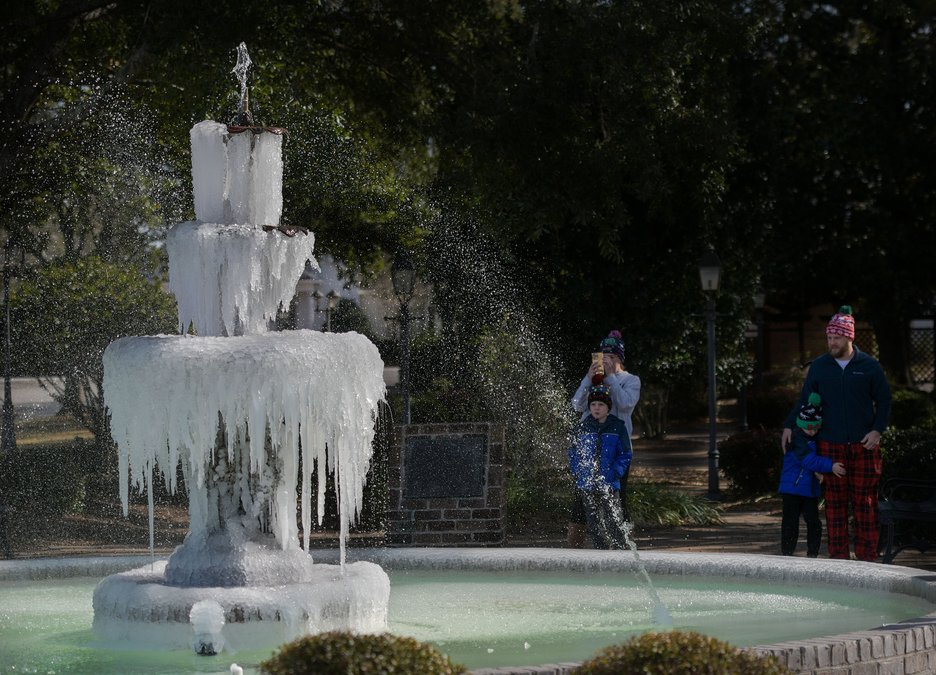Water fountains are a valuable addition to your outdoor space. They are associated with beauty and calm, and this is true even during winter. But does that mean it’s wise to leave them outside during the frosty winter season?
As winter and its accompanying harsh conditions set in, you may be wondering whether it’s safe to leave your water fountain outside.
Will your water fountain endure the fury of winter? Or will the freezing temperatures cause it to freeze, crack, and crumble?

Keep reading this article, and you’ll find out. It will explore the possibilities and tell you how to protect your outdoor water fountain during the winter months.
What Happens When You Leave a Water Fountain Outside in Harsh Winter Conditions?
During winter, your outdoor water fountain is susceptible to a variety of risks. These include:
Cracks
During winter, the temperature drops below the freezing point. When this happens, any water left in the fountain can freeze and expand. This expansion can cause cracks and result in structural damage to your water fountain.
The fountain's structure, including the bowl and reservoir, can crack and weaken. Even if the fountain is not running, ice can still form in the cracks and joints, leading to damage.
Frost and Snow
Apart from temperature drops, your water fountain is also susceptible to damage from frost and snow. For instance, snow buildup can add extra weight, and this heavier load can weaken the fountain's structure.
Frost can also cause ice to form inside the fountain's pump and tubing, which can cause breakdowns or even permanent damage.
Types of Outdoor Fountains Requiring Special Winter Protection
Not all outdoor water features require the same outdoor fountain winter care strategies.

Concrete or stone fountains are prone to moisture retention due to their porous structure, accelerating crack formation through freeze-thaw cycles.
Ceramic or pottery materials, with their high brittleness, can shatter under minor ice pressure in low temperatures.
Metal fountains risk corrosion and perforation if water pooling in joints is not thoroughly drained.
Additionally, the complex piping systems of multi-tiered fountains may experience pump explosions if residual water freezes when not completely drained. Meanwhile, shallow birdbath-style fountains freeze rapidly due to their limited water reservoirs, necessitating prioritized freeze prevention measures.
How to Protect Your Water Fountain During Winter
Step1. Winterization
This is the process of preparing your water fountain for the harsh conditions of winter. To winterize your water fountain, follow these steps:
Completely Drain the Fountain
Start by turning off the fountain and draining the water. Water is one of the major causes of fountain damage in the winter. It expands when frozen and can cause damage to the fountain.
Most fountains have a drain plug you can pull for easy drainage. If yours doesn't, you can use a container to scoop out the water.
Disassemble the Outdoor Fountain
While you don't have to tear the fountain completely apart, try to dismantle it. This includes taking out the pump, hose, accessories, and other parts of the fountain.
Clean the Fountain
After uninstalling the parts, you should clean out the fountain and the pump to prevent algae growth. To do this, check out our step-by-step guide on how to clean your outdoor fountain and pump.
Place Absorbent materials
Once your fountain is clean and dry, place dry towels or blankets in the basin or bowl. These absorbent materials will soak in any water or moisture that finds its way in. By lining the fountain basin with these fabrics, water can't seep into the cracks and cause damage.
Store the Pump Away
To prevent the pump from freezing and getting damaged, keep it in a cool, dry, and dust-free area. Depending on your pump type, you can also store it in a bucket full of clean water.
If you're storing your pump dry, make sure the pump is completely dry. On the other hand, if you're storing the pump in a bucket of water, make sure that you keep or monitor it so that the water does not freeze.
Store or Cover the Fountain
If possible, move your water fountain indoors and store it in a dry, sheltered space. If you don't want to do this (especially where the fountain is too large to be moved), use a fountain cover, a tarp, or other suitable materials to protect the fountain from snow, ice, and debris.
As you do this, make sure there's a snug fit to prevent any moisture from seeping in.
Monitor and Maintain
As temperatures fluctuate, inspect your water fountain regularly for signs of damage. You should also check the fountain cover and make necessary adjustments if weather conditions change. And don't forget to look out for common issues like condensation buildup from inadequate ventilation or snow or debris deposits.
Step2. Insulation to prevent freezing
Consider insulating the pipes and fountain to provide additional protection against freezing temperatures during winter. Insulating your pipes and fountain will prevent water from freezing inside them, thus reducing the risk of damage.
Why insulation matters for frozen fountains
Water trapped in hairline seams expands by nearly 9 % as it freezes, popping concrete faces and snapping brittle PVC. Adding even a modest R-2 to R-4 barrier around vulnerable parts cuts heat loss enough that daytime sun or pump-motor warmth can keep them above 32°F (0 °C).
Installation checklist
-
Dry run inspection: After you completely drain the fountain, wipe bowls bone-dry so no water is sealed under the insulation.
-
Wrap pipes first: Slide foam or fiberglass sleeves over every exposed line, then seam-seal with outdoor-rated tape.
-
Add absorbent base: Lay microfiber cloths or old towels in the basin to wick stray drip-water before it can refreeze.
-
Apply heat cable (optional): Zip-tie self-regulating cable along critical runs; route the thermostat sensor to the coldest exterior face.
-
Jacket & cover: Slide on a breathable quilted fountain cover; tighten the drawcord and buckle straps to stop wind lofting while still venting humidity.
-
Eco-safe antifreeze backup: In extreme climates, circulate a propylene-glycol RV formula in hidden sump lines; it’s non-toxic to pets and birds.
Step3. De-Icing Without Harming Wildlife
To prevent the water in your fountain from freezing, you can consider adding antifreeze. However, we do not recommend this because it comes with several risks.

Antifreeze or de-icing products can damage your water fountain and can even be toxic to humans and animals. If you choose to go this route, though, make sure you look for non-toxic de-icing solutions and follow the manufacturers’ instructions to avoid damaging your fountain.
Antifreeze or de-icing products can damage your water fountain and can even be toxic to humans and animals. If you choose to go this route, though, make sure you look for non-toxic de-icing solutions and follow the manufacturers' instructions to avoid damaging your fountain.
Avoid ethylene glycol automotive antifreeze, which is harmful to pets and birds
If pipes cannot drain, use a propylene glycol-based RV/pond antifreeze formula, which is much less toxic than propylene glycol but still keeps pets out.
For large ponds with fountain nozzles, a floating thermostatic de-icer creates a dinner plate-sized hole in the ice to allow trapped expanding gases to escape.
Should You Run Your Outdoor Water Fountain In Winter?
Typically, it is recommended that you keep your water fountain running 24/7. This is because it is necessary to maintain water circulation and prevent stagnation.
However, do not do this during winter! Why? When water starts to freeze, it can cause cracks and damage, and even if you apply insulation, water can still spill from the fountain and get into cracks in the fountain walls.

When this happens, the water can freeze and expand the fountain material, putting pressure on it. To compound the problem, when the water melts, contraction happens begins as well.
This expansion and contraction can weaken your fountain over time. So, unless you're actually trying to cause damage, do not run your fountain during winter.
When Can You Leave Your Outdoor Fountain Outside In The Winter?
Winter might be a concern for outdoor fountains, but remember that winter is not the same everywhere.
Some regions may experience winter differently from others. If you stay in an area with mild winters like Miami, FL, Austin, TX, or San Diego, CA, then you can likely leave your water fountain outside throughout the year.
However, if you stay in areas with harsher winters, like Anchorage, AK or Boston, MA, then you should take special care and follow the tips in this article to prolong the lifespan of your water fountain.
Note: Even if you live in an area with mild winters, you should still monitor your water fountain, especially during cold spells.
How to Prepare Frozen Fountains for Spring?
Winterization protects your feature, but a smart outdoor-fountain winter-care routine ends with a methodical spring reboot.
Uncover & Inspect
Peel off the cover only after daytime highs stay above freezing so any residual ice can soften. Brush away leaves, then run gloved fingers and a flashlight along seams and bowl interiors to spot hairline cracks or flaking caused by freeze-thaw stress
Deep-Clean & Re-seal
Next, give the basin, tiers, and pump a “spa day.”
Remove the pump cover, flush the impeller cavity, and back-flush any tubing with a garden hose. A fountain-safe descaler (look for citric-acid or vinegar bases) lifts winter mineral rings without etching finishes
If your unit is painted or glazed, let the sealer cure for 24 hours before refilling to avoid clouding the finish.
Reinstall, Top Off & Monitor
Re-seat the pump, lubricate O-rings with silicone grease, and hand-tighten all tubing clamps. Plug the cord into a GFCI-protected outlet and press the “test” button.
Now refill the basin, power the pump, and let the fountain run for a full thirty minutes. Mark the water line; if it drops, shut the unit down and track seepage at joints or hose fittings before regular operation.
Conclusion
Leaving your water fountain outside in the winter may not be the best idea. By following the tips in this article, you can prevent water damage and prolong the lifespan of your fountain.
Even though outdoor fountains need extra care during winter, the peace and beauty they bring are worth it. Check out our collection of outdoor fountains and find the right one for you.
FAQs About Leaving a Water Fountain Outside in Cold Weather
Q1: What Materials Are Best For Outdoor Fountains In Winter?
Fountains made from basalt, granite, and other natural stones tend to handle cold temperatures better than other fountain materials. Although you don't have to cover them during winter, to protect these types of fountains from damage, you should still employ appropriate winterization techniques.
Q2: What Temperature Does a Water Fountain Freeze?
Once the temperature drops below 32°F (0°C), fountain water starts to freeze. To prevent damage caused by this freezing water, you should always winterize or store your fountain indoors.
Q3: How Often Should I Check My Fountain During Winter?
Inspect your water fountain at least once a month during winter, or more (if possible). You should be on the lookout for signs of moisture, damage, or issues with the fountain cover.

Leave a comment